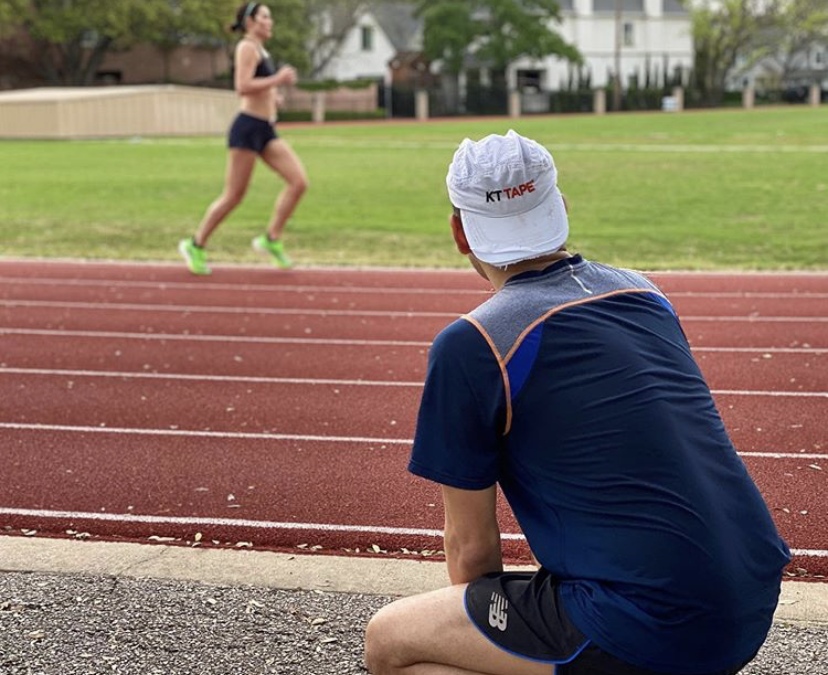By: Alfonzo Gonzalez Jr
With the current pandemic disrupting our daily routines and lifestyles, we are scrambling to hold onto a sense of normalcy. However, we have had to modify both thought and behavioral processes in order to stay safe and keep others safe. Today, fitness enthusiasts of all categories are using this time to continue their regular schedules of waking up early, working out, and eating a healthy breakfast. As a running coach, it is important to keep all of the athletes motivated during these ambiguous times. I recognize it can be tempting for many to settle into a complacent mindset due to events being cancelled; therefore, communication is crucial. Platforms such as email, social media, or text message are now being used to provide runners with individualized attention to discuss progress and conditioning after daily runs.
During this time, training has centered on maintaining quality workouts, speed, and mileage. As each athlete has a personal goal he or she wishes to achieve – whether it is qualifying for the Olympic Trials, Boston Marathon, or even breaking the four-hour benchmark – these challenging runs during the week help runners focus on maintaining the pace required to achieve these standards. Although most races have now transferred to virtual events, training still allows athletes the opportunity to assess both foundation and fitness levels. For beginners, the accomplishment of completing ten to twenty miles per week creates a robust groundwork from which to grow.
Today, several athletes are using this down time for recovery. I encourage my athletes to listen to their bodies and to communicate with me about how they are feeling. I emphasize to all my athletes that the most important part of training is to enjoy the journey, along with a self-reminder of why they run daily. In order to keep my athletes inspired, I employ simulation runs, which imitate a practice race. Whether it is a mile, 5K, 10K, or a half marathon, a simulation run provides athletes the opportunity to comprehend where their fitness levels are at. If an athlete does not reach his or her goal during a simulation run, I focus on forming a plan of action to help develop his or her speed. These runs may seem intimidating to some; however, I remind athletes that these runs create an opportunity to build fitness and endurance, especially during the pandemic.
Cross training is an effective method to alternate with running. Many runners are now enjoying activities ranging from yoga, biking, hockey, strength training, Pilates, and swimming. Cross training offers numerous ways to keep the runners’ bodies active while working different muscle groups. These different outdoor sports help my athletes stay engaged with running, while allowing them to refocus on their training. I am able to provide support and direction outside of running with regard to cross training activities and how they are handling the workouts. Some athletes have mentioned that they actually feel stronger with different forms of exercise in addition to their training. Additionally, cross training is especially beneficial when an athlete may need a down-week to allow his or her body to recover.
Social distancing requirements have caused some people to train by themselves and outside of their normal running groups. In these situations, it is easy for runners to lose motivation during quality workouts. As a coach, I connect with my runners on a daily basis to provide verbal encouragement and bolster their efforts. Occasionally when ten or more people congregate, we divide into two smaller groups to follow safety guidelines: one group will focus on hill repeats, while the other group focuses on a speed workout at the track.
With many of my runners prepping for virtual races, I try to accompany them on their difficult runs. Although I am not able to join every long run or workout, I try to ensure that athletes pair up to run at the same pace and to support each other. During the week, I alternate between groups in order to provide each athlete with the coaching he or she needs. I rotate between my runners as each has a different pace and target goal. At times when a runner is struggling to complete his or her workout, I run alongside to motivate the runner to hit the required pace. I feel it is important to work with my athletes during training cycles to provide them with individualized attention, guidance, and support.
Every month, I communicate with each of my athletes to evaluate his or her progress and to adjust the training plan if necessary. This meeting also affords me an opportunity to discuss what is happening in their lives outside of running. I explain to my athletes that training can always be customized to fit the user’s life-style and schedule; each runner has a certain time of day he or she prefers to run, whether it is early in the morning, midday, or afternoon. Additionally, some athletes choose to alternate their runs between morning and afternoon to adapt to the different temperatures throughout the day and week.
As we are still working to overcome the pandemic, open communication is crucial to having a successful training cycle. As a coach, I recognize that I usually hear from my runners on days where they have quality workouts and long runs. My athletes know they can contact me, whether they have a successful run or are struggling during a workout, as I firmly believe that open and constant communication builds trust. As a result of my collaborative approach, my athletes have referred me to other runners looking for direction in achieving their personal goal.
Although these are certainly challenging times with safety being a high priority, I have been fortunate to continue working with my athletes to help them accomplish their dreams and goals. I wish to encourage all my athletes to continue to train and to stay focused, but strongly emphasize the need for following social distancing and safety guidelines. Together, we can finish strong and beat this pandemic!

Alfonzo Gonzalez Jr @ifonzz or by referral
